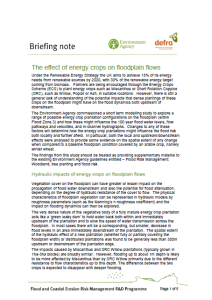The effect of energy crops on floodplain flows – briefing note
 A year ago I wrote a blog calling on the Environment Agency to officially publish a report and briefing note that was produced back in 2010 about the possible impacts (good and bad) of planting energy crops on flood plains. Unfortunately, the report and briefing note are still invisible on the internet so I have decided to post them here.
A year ago I wrote a blog calling on the Environment Agency to officially publish a report and briefing note that was produced back in 2010 about the possible impacts (good and bad) of planting energy crops on flood plains. Unfortunately, the report and briefing note are still invisible on the internet so I have decided to post them here.
The work was carried out by JBA Consulting and the aim of the work was three fold:
- To make sure that energy crop applications under the Energy Crops Scheme were not unnecessarily refused on a precautionary basis
- To explore a range of energy crop plantation configurations on the floodplain and how these might influence 1 in 100 year flood water levels
- To inform new guidance and practice regarding energy crops on floodplains and supplement EA guidelines entitled Flood Risk Management: Woodland, tree planting and flood risk.
The report and briefing note are cautious in their recommendations (as a result of the limitations of the model based on just two case study floodplains and the lack of other published information on roughness characteristics of energy crops) but broadly support this application of energy crops.
The briefing note says:
“In line with the long term objectives of the Catchment Flood Management Plans (CFMPs) these energy crop plantations could potentially have an important role to play in helping to manage smaller-scale flooding problems where the high cost of constructing hard defences cannot be justified. These plantations could also make a valuable contribution to tackling the increased risk of flooding associated with climate change”.
The report also calls for a more robust modelling exercise as well as laboratory and field studies.
JBA consulting also produced a scientific paper on this work which is posted here.
This work needs to be taken forward. The Forestry Commission are able to offer grants to landowners planting native trees in areas where they may help flood mitigation. Energy crops like miscanthus and short rotation coppice (SRC) have higher hydraulic roughness and grow much quicker so are arguably much more effective at holding back flood waters. Government agencies should recognise this and provide some funding for more research and grants for planting energy crops in critical flood prone areas.